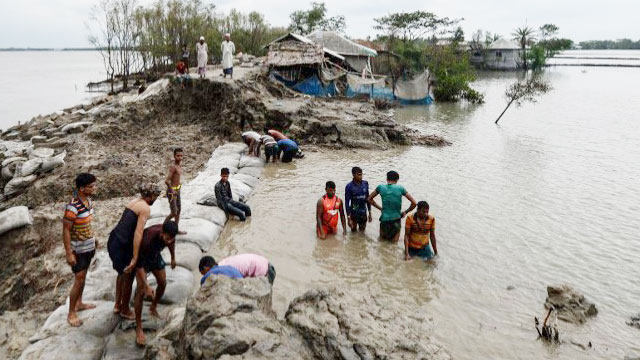India and Bangladesh began a massive clean-up on Thursday after the fiercest cyclone since 1999 killed at least 95 people, leaving a trail of destruction in its wake.
Cyclone Amphan flattened houses, uprooted trees, blew off roofs and toppled electricity pylons, while a storm surge inundated coastal villages and wrecked shrimp farms vital to the local economy.
The United Nations office in Bangladesh estimates one crore people were affected, and some 5 lakh people may have lost their homes.
But the death toll was far lower than the many thousands killed in previous cyclones — a result of improved weather forecasting and better response plans.
The disaster has raised fears, however, that overcrowding in storm shelters will exacerbate the spread of coronavirus.
India’s West Bengal reported 72 deaths — including 15 in the capital Kolkata — with state premier Mamata Banerjee saying: ‘I haven’t seen a disaster of this magnitude.’
‘This is the worst cyclone to hit the state since the one in 1737 when thousands lost their lives,’ she told reporters. Banerjee earlier described the cyclone’s impact as ‘worse than coronavirus’.
Twenty-three people have died in Bangladesh, according to the official death toll.
India’s prime minister Narendra Modi will survey the damage in West Bengal and Odisha states on Friday, as well as take part in aid meetings.
Modi tweeted earlier that ‘no stone will be left unturned in helping the affected’.
Improved weather forecasting meant Bangladesh was able to move some 2.4 million people into shelters or out of the storm’s direct path, while India evacuated some 6.5 lakh.
At least 1 crore people were without power on Thursday afternoon in the worst-hit districts of Bangladesh, said rural electricity board chief Moin Uddin.
The storm levelled more than 55,000 homes — most made of tin, mud and bamboo — across Bangladesh, disaster management state minister Enamur Rahman told AFP.
Kolkata residents woke to flooded streets, with part of the city’s yellow taxi fleet up to their bonnets in water in one neighbourhood and many areas without power.
‘Each second seemed like an hour,’ bank manager Susanta De said of the storm.
‘There were only howling winds and sounds of shattering window panes. All of it was very scary and we thought the end was nearing.’
Bangladesh’s Sunderbans forest chief Moyeen Uddin Khan told AFP the storm surge that smashed into the vast mangrove area — which bore the brunt of the storm — was ‘not as high as was feared earlier’.
He said Amphan’s impact on wildlife, especially the forest’s endangered Bengal tigers, was not yet known.-AFP





